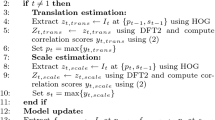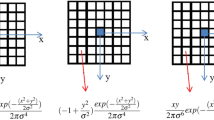Abstract
Scale and rotation invariant salient point detection and matching algorithms are variously used in computer vision applications such as image matching, 3D localization and pose estimation. Recently, hardware implementation of image and video processing algorithms has emerged as a viable solution to handle the high computational complexity of applications like 3D pose estimation with several processing stages. The hardware implementation of various stages of theses algorithms can be executed in a pipelined manner to ensure the reality of time. In this paper, a new and fully pipelined hardware architecture is proposed for salient point detection using Binary Robust Invariant Scalable Keypoints (BRISK) algorithm. BRISK algorithm is a binary keypoint extractor that detects salient points by constructing a scale-space pyramid; therefore, its fixed-point hardware implementation in a pipelined manner is challenging because of the required synchronization for various layers in scale domain. The proposed hardware architecture was implemented using Verilog Hardware Description Language, and the functionality of the design was validated through several experiments. The proposed design was synthesized by using an ASIC digital design flow utilizing 180 nm CMOS technology as well as a Virtex-4 FPGA. The design is clocked at 90.91 MHz in ASIC implementation and achieves processing rate of 169.29 frames/s while running on input images with 800 × 600 resolution. The throughput of FPGA implementation is 180.44 frames/s with 96.89 MHz clock frequency for the same input image resolution. Experimental results confirm the efficiency of the proposed hardware architecture in comparison with software implementation.





















Similar content being viewed by others
References
Harris, C., Stephens, M.: A combined corner and edge detector. In: Proceedings of the Fourth Alvey Vision Conference 1988, pp. 147–151
Moravec, H.P.: Obstacle Avoidance and Navigation in the Real World by a Seeing Robot Rover. Stanford University, Stanford (1980)
Shi, J., Tomasi, C.: Good features to track. In: IEEE Computer Society Conference on Computer Vision and Pattern Recognition (CVPR), Seattle, WA, USA, pp. 593–600. IEEE (1994)
Lowe, D.G.: Distinctive image features from scale-invariant keypoints. Int. J. Comput. Vis. 60(2), 91–110 (2004)
Yao, L., Feng, H., Zhu, Y., Jiang, Z., Zhao, D., Feng, W.: An architecture of optimised SIFT feature detection for an FPGA implementation of an image matcher. In: International Conference on Field-Programmable Technology (FPT), pp. 30–37. IEEE (2009)
Grabner, M., Grabner, H., Bischof, H.: Fast approximated SIFT. In: 7th Asian Conference on Computer Vision (ACCV), Hyderabad, India, pp. 918–927. Springer, Berlin (2006)
Ke, Y., Sukthankar, R.: PCA-SIFT: A more distinctive representation for local image descriptors. In: IEEE Computer Society Conference on Computer Vision and Pattern Recognition (CVPR), Washington, DC, USA, Vol. 502, pp. II-506–II-513. IEEE (2004)
Bay, H., Tuytelaars, T., Van Gool, L.: Surf: speeded up robust features. In: 9th European Conference on Computer vision (ECCV), Graz, Austria, pp. 404–417. Springer, Berlin (2006)
Rosten, E., Drummond, T.: Fusing points and lines for high performance tracking. In: Tenth IEEE International Conference on Computer Vision (ICCV) Beijing, China, pp. 1508–1515. IEEE (2005)
Mair, E., Hager, G.D., Burschka, D., Suppa, M., Hirzinger, G.: Adaptive and generic corner detection based on the accelerated segment test. In: 11th European Conference on Computer Vision (ECCV), Heraklion, Crete, Greece, pp. 183–196. Springer, Berlin (2010)
Leutenegger, S., Chli, M., Siegwart, R.Y.: BRISK: Binary robust invariant scalable keypoints. In: IEEE International Conference on Computer Vision (ICCV), Barcelona, Spain, pp. 2548–2555. IEEE (2011)
Pedre, S., Krajník, T., Todorovich, E., Borensztejn, P.: Accelerating embedded image processing for real time: a case study. J. Real-Time Image Proc. 11(2), 349–374 (2016)
Velez, G., Cortés, A., Nieto, M., Vélez, I., Otaegui, O.: A reconfigurable embedded vision system for advanced driver assistance. J. Real-Time Image Proc. 10(4), 725–739 (2015)
Wang, W., Yan, J., Xu, N., Wang, Y., Hsu, F.-H.: Real-time high-quality stereo vision system in FPGA. IEEE Trans. Circuits Syst. Video Technol. 25(10), 1696–1708 (2015)
Sivanantham, S., Paul, N.N., Iyer, R.S.: Object tracking algorithm implementation for security applications. Far East J. Electron. Commun. 16(1), 1–13 (2016)
Azizabadi, M., Behrad, A., Ghaznavi-Ghoushchi, M.: VLSI implementation of star detection and centroid calculation algorithms for star tracking applications. J. Real-Time Image Proc. 9(1), 127–140 (2014)
Araneda, L., Figueroa, M.: A compact hardware architecture for digital image stabilization using integral projections. Microprocess. Microsyst. 39(8), 987–997 (2015)
Bonato, V., Marques, E., Constantinides, G.: A parallel hardware architecture for scale and rotation invariant feature detection. IEEE Trans. Circuits Syst. Video Technol. 18(12), 1703–1712 (2008)
Huang, F.-C., Huang, S.-Y., Ker, J.-W., Chen, Y.-C.: High-performance SIFT hardware accelerator for real-time image feature extraction. IEEE Trans. Circuits Syst. Video Technol. 22(3), 340–351 (2012)
Suzuki, T., Ikenaga, T.: SIFT-based low complexity keypoint extraction and its real-time hardware implementation for full-HD video. In: 2012 Asia-Pacific Signal & Information Processing Association Annual Summit and Conference (APSIPA ASC), California, USA, pp. 1–6. IEEE (2012)
Chang, L., Hernández-Palancar, J., Sucar, L.E., Arias-Estrada, M.: FPGA-based detection of SIFT interest keypoints. Mach. Vis. Appl. 24(2), 371–392 (2013)
Zhong, S., Wang, J., Yan, L., Kang, L., Cao, Z.: A real-time embedded architecture for SIFT. J. Syst. Architect. 59(1), 16–29 (2013)
Chiu, L.-C., Chang, T.-S., Chen, J.-Y., Chang, N.Y.-C.: Fast SIFT design for real-time visual feature extraction. IEEE Trans. Image Process. 22(8), 3158–3167 (2013)
Jiang, J., Li, X., Zhang, G.: SIFT hardware implementation for real-time image feature extraction. IEEE Trans. Circuits Syst. Video Technol. 24(7), 1209–1220 (2014)
Sledevič, T., Serackis, A.: SURF algorithm implementation on FPGA. In: 13th Biennial Baltic Electronics Conference (BEC), Tallinn, Estonia, pp. 291–294. IEEE (2012)
Wilson, C., Zicari, P., Craciun, S., Gauvin, P., Carlisle, E., George, A., Lam, H.: A power-efficient real-time architecture for SURF feature extraction. In: International Conference on ReConFigurable Computing and FPGAs (ReConFig), pp. 1–8. IEEE (2014)
Zhang, W., Liu, L., Yin, S., Zhou, R., Cai, S., Wei, S.: An efficient VLSI architecture of speeded-up robust feature extraction for high resolution and high frame rate video. Sci. China Inf. Sci. 56(7), 1–14 (2013)
Battezzati, N., Colazzo, S., Maffione, M., Senepa, L.: SURF algorithm in FPGA: a novel architecture for high demanding industrial applications. In: Design, Automation & Test in Europe Conference & Exhibition (DATE), Dresden, pp. 161–162 (2012)
Krajník, T., Šváb, J., Pedre, S., ížek P, P., Peuil, L.: FPGA-based module for SURF extraction. Mach. Vis. Appl. 25(3), 787–800 (2014)
Heo, H., Lee, J.-Y., Lee, K.-Y., Lee, C.-H.: FPGA based implementation of FAST and BRIEF algorithm for object recognition. In: TENCON 2013–2013 IEEE Region 10 Conference (31194), pp. 1–4. IEEE (2013)
Park, J.-S., Kim, L.-S.: Hardware accelerator for feature point detection and matching. In: Jaeseok Kim, H.S. (ed.) Algorithm & SoC Design for Automotive Vision Systems, pp. 197–230. Springer, New York (2014)
Heinly, J., Dunn, E., Frahm, J.-M.: Comparative evaluation of binary features. In: Computer Vision–ECCV 2012, pp. 759–773. Springer, NewYork (2012)
Rublee, E., Rabaud, V., Konolige, K., Bradski, G.: ORB: an efficient alternative to SIFT or SURF. In: 2011 IEEE International Conference on Computer Vision (ICCV), pp. 2564–2571. IEEE (2011)
Bekele, D., Teutsch, M., Schuchert, T.: Evaluation of binary keypoint descriptors. In: 20th IEEE International Conference on Image Processing (ICIP), pp. 3652–3656. IEEE (2013)
Alahi, A., Ortiz, R., Vandergheynst, P.: Freak: Fast retina keypoint. In: 2012 IEEE Conference on Computer Vision and Pattern Recognition (CVPR), pp. 510–517. IEEE (2012)
Canclini, A., Cesana, M., Redondi, A., Tagliasacchi, M., Ascenso, J., Cilla, R.: Evaluation of low-complexity visual feature detectors and descriptors. In: 18th International Conference on Digital Signal Processing (DSP), pp. 1–7. IEEE (2013)
Quinlan, J.R.: Induction of decision trees. Mach. Learn. 1(1), 81–106 (1986)
Oxford Image Dataset. http://www.robots.ox.ac.uk/~vgg/data/data-aff.html. Accessed Feb 2017
Bouris, D., Nikitakis, A., Papaefstathiou, I.: Fast and efficient FPGA-based feature detection employing the SURF algorithm. In: 18th IEEE Annual International Symposium on Field-Programmable Custom Computing Machines (FCCM), pp. 3–10. IEEE (2010)
Schaeferling, M., Kiefer, G.: Flex-SURF: A flexible architecture for FPGA-based robust feature extraction for optical tracking systems. In: 2010 International Conference on Reconfigurable Computing and FPGAs (ReConFig), pp. 458–463. IEEE (2010)
Lee, S.-S., Jang, S.-J., Kim, J., Hwang, Y., Choi, B.: Memory-efficient SURF architecture for ASIC implementation. Electron. Lett. 50(15), 1058–1059 (2014)
Author information
Authors and Affiliations
Corresponding author
Rights and permissions
About this article
Cite this article
Azimi, E., Behrad, A., Ghaznavi-Ghoushchi, M.B. et al. A fully pipelined and parallel hardware architecture for real-time BRISK salient point extraction. J Real-Time Image Proc 16, 1859–1879 (2019). https://doi.org/10.1007/s11554-017-0693-4
Received:
Accepted:
Published:
Issue Date:
DOI: https://doi.org/10.1007/s11554-017-0693-4




